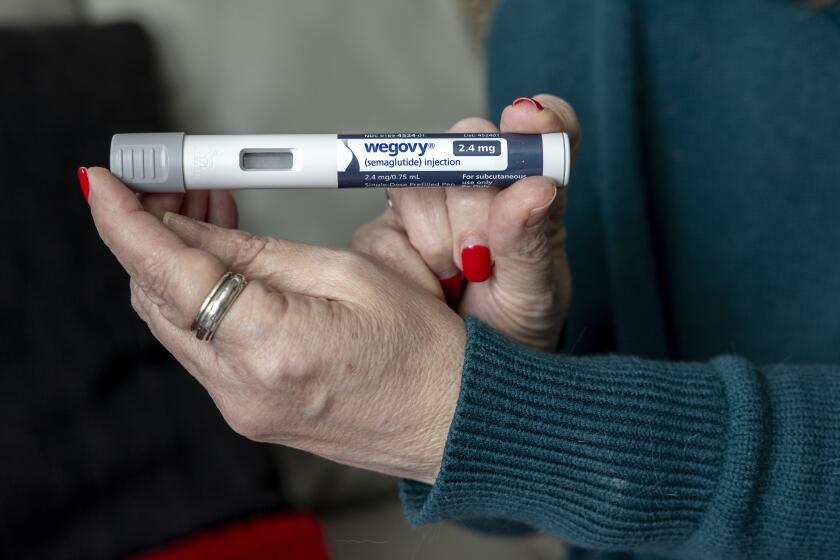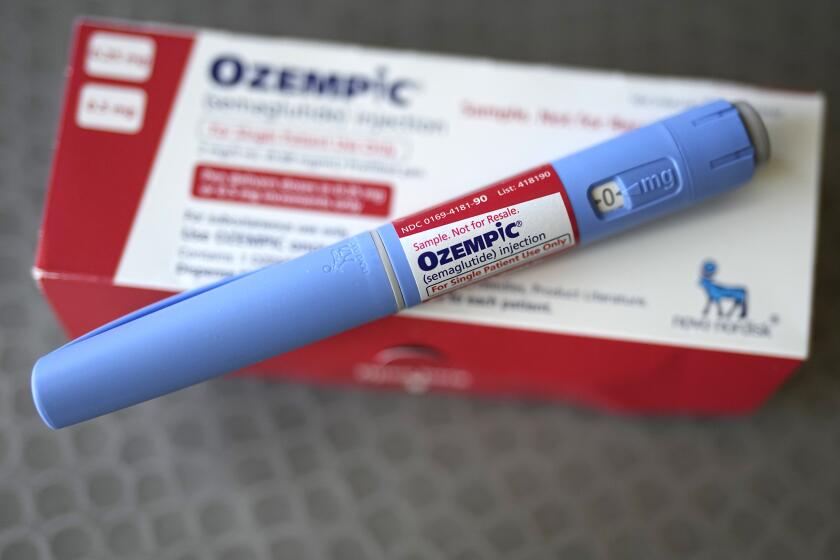Millions of Americans need drugs like Ozempic. Will it bankrupt the healthcare system?

An April 24 letter from Vermont Sen. Bernie Sanders to the CEO of Novo Nordisk began with heartfelt thanks to the Danish drugmaker for inventing Ozempic and Wegovy, two medications poised to improve the health of tens of millions of Americans with obesity and related diseases.
But the senator’s grateful tone faded rapidly.
“As important as these drugs are, they will not do any good for the millions of patients who cannot afford them,” Sanders wrote. “Further, if the prices for these products are not substantially reduced they also have the potential to bankrupt Medicare, Medicaid, and our entire health care system.”
It’s a sentiment that comes up regularly among people who are huge fans of the medications and their close relatives, Eli Lilly’s Mounjaro and Zepbound. All of them work by masquerading as a natural hormone called GLP-1 and tricking the body into slowing digestion and reducing blood sugar.
The medications help patients lose double-digit percentages of their body weight and keep it off — an average of 12.4% in the clinical trial for Wegovy, and an average of 18% at the highest dose in the trial for Zepound. It’s rare for insurance companies to cover GLP-1 drugs for weight loss alone, and Medicare is forbidden by law from doing so. But as the pounds fall, so do the risks of serious problems like type 2 diabetes, hypertension, heart attacks and strokes, and the medications can be covered to prevent these conditions.
“Obesity is a huge public health crisis, and for so long we had no treatments that really made a difference,” said Dr. Lauren Eberly, a cardiologist and health services researcher at the University of Pennsylvania. “These medicines could change the trajectory of your disease and save your life.”
That makes these drugs extremely valuable. Unfortunately, they’re also extremely expensive.
The sticker price for Ozempic, which the Food and Drug Administration approved to treat type 2 diabetes, is more than $12,600 per year. Wegovy, a higher-dose version approved for weight loss in people with obesity and as a way for overweight patients with cardiovascular disease to reduce their risk of heart attack and stroke, retails for nearly $17,600 a year.
Ozempic and other drugs raised the possibility of reversing the country’s obesity crisis. Doctors are frustrated that they’ve made health disparities worse.
Mounjaro and Zepbound mimic GLP-1 as well as a related hormone called glucose-dependent insulinotropic peptide, or GIP. Their list prices add up to roughly $13,900 per year for Mounjaro, which is approved as a diabetes treatment, and about $13,800 per year for Zepbound, the weight-loss version.
Eberly said those prices are simply too high.
“We as a public health medical community — and the community at large — really need to advocate for increased affordability,” she said. “I think we’re overdue for a real reckoning on this.”
In the United States, the tab for these GLP-1 drugs is exorbitant almost any way you look at it.
In 2022, the prescription drug that accounted for the biggest share of Medicare Part D spending was the blood thinner Eliquis. More than 3.5 million beneficiaries used it that year, at a cost of $15.2 billion, the U.S. Department of Health and Human Services says.
That total was more than double the amount spent on the next-costliest drug, the type 2 diabetes medication Trulicity, according to the Centers for Medicare and Medicaid Services, or CMS.
But $15.2 billion is practically a rounding error compared to the $268-billion price tag if Wegovy were to be provided to all 19.7 million Medicare beneficiaries with obesity, researchers estimated in the New England Journal of Medicine.
Even if the drug were prescribed only to Medicare patients with a clinical diagnosis of obesity, the cost would exceed $135 billion. That’s more than the $130 billion Medicare spent on all retail prescription drugs in 2022, according to CMS.
“This is a real budgetary situation for CMS,” said Melissa Barber, a public health economist who studies pharmaceutical policy at Yale School of Medicine. “They’re going to have to deal with this.”
No matter how expensive a drug, it’s “extremely unlikely” that Medicare would actually go bankrupt, a CMS spokesperson said. Spending for the Medicare Part B and Part D programs is reset every year, and if it goes up, beneficiaries and the government share the burden of covering the difference, the spokesperson said.
Sanders offered another perspective. A report released this month by the Senate Health, Education, Labor, and Pensions Committee, which he chairs, noted that Americans get charged $1,349 for a 28-day supply of Wegovy, while the same amount of the medication goes for $186 in Denmark, $137 in Germany and $92 in the United Kingdom.
“The prices for these drugs are so high in the United States that everyone — regardless of whether they use the products or not — will likely be forced to bear the burden of Novo Nordisk’s profit maximizing strategy through higher insurance premiums and taxes,” Sanders wrote in his letter to the company.
The financial impact on Medicare is tempered by a 2003 federal law that prevents the government health insurance program from covering weight-loss medications.The drugs can be added to formularies if prescribed for another “medically accepted indication,” such as to treat type 2 diabetes or reduce heart risk, but patients can’t get it if their only medical issue is obesity.
Rep. Brad Wenstrup (R-Ohio) has introduced a bill that would reverse that 2003 ban. Though the Treat and Reduce Obesity Act has 97 co-sponsors from both sides of the aisle, its financial implications have made it difficult to muster the votes needed for the legislation to advance, he said.
Indeed, Phillip Swagel, director of the Congressional Budget Office, said last month that if the goal was to provide weight-loss drugs without increasing the deficit, their net cost would need to fall by a factor of 10 just to “get in the ballpark.”
Semaglutide medications such as Ozempic have been a breakthrough for health and diabetes management, but they require a prescription and can be expensive.
Dr. Caroline Apovian, co-director of the Center for Weight Management and Wellness at Brigham and Women’s Hospital in Boston, is concerned that the budget-busting potential of Wegovy and Zepbound has made private health insurers too scared to cover them.
“No insurance company is going to be able to afford to give these lifesaving drugs to the 42% of Americans with obesity,” she said. “So we have to do something.”
Exactly what that something should be is not clear.
One possibility is for the federal government to ask Novo Nordisk and Eli Lilly to discount their GLP-1 drugs. The Inflation Reduction Act empowers Medicare to negotiate lower prices for 10 medicines each year, and researchers in the Congressional Budget Office expect at least some GLP-1s to make the list “within the next few years.”
Private insurers are free to seek deals of their own, and the similarities between the Novo Nordisk and Eli Lilly drugs give insurers quite a lot of bargaining power, said John Cawley, a health economist at Cornell.
“They should be more effective at playing them off each other,” Cawley said. “They can say, ‘We’re only going to cover one of these. Which do you want to be, the one we cover or the one we don’t?’”
There’s reason to think the drugmakers could afford to offer significant discounts if they were so inclined.
Novo Nordisk charges Americans $968.52 for a 28-day supply of Ozempic, regardless of whether the dose of the active ingredient semaglutide is 0.5, 1 or 2 milligrams per injectable pen. Likewise, Wegovy is priced at $1,349.02 every 28 days, no matter whether the weekly injections contain 0.25, 0.5, 1, 1.7 or 2.4 mg of semaglutide.
Yet a 2022 report in the journal Obesity estimated that a 2.4-mg weekly dose of semaglutide could be made for “about $40” a month.
Barber is part of a team that also examined what it would cost to produce various diabetes drugs using methods designed to keep prices low. Her group calculated that a 30-day supply of an injectable medicine with 0.77 milligrams of semaglutide could be manufactured for as little as 89 cents, a total that includes a 10% profit. Even with higher costs and a 50% profit, the drug could be made for $4.73 a month, the team reported in March in JAMA Network Open.
“They could be very affordable,” Barber said.
A spokeswoman for Novo Nordisk said the company was “unaware of the analysis” used in the study, but it recognizes the need to find ways to make its products more affordable. She also said the company is reviewing the report from Sanders’ Senate committee and noted that “75% of our gross US sales goes to rebates and discounts reimbursed to insurance companies and other payers.”
Representatives from Eli Lilly did not comment on the cost of its drugs.
If manufacturers don’t agree to reduce prices voluntarily, the federal government could take more forceful steps. The Inflation Reduction Act put a $35-a-month limit on what seniors with Medicare Part D plans need to pay for insulin. Congress could set a limit on GLP-1 drug prices too, though that would be “a last resort,” said Lawrence Gostin, an authority on public health law at Georgetown University.
Patients taking Ozempic and other trendy injectables are going under the knife to correct the side effects of rapid weight loss, which include sagging skin, hollow cheeks and an aged appearance.
Rationing the drugs is another way to keep spending in check, health economists say. High sticker prices have limited access to the drugs, often making income a determining factor in deciding who can take them and who must go without. But there are other ways to prioritize patients.
A person with a “healthy weight” — defined as a body mass index between 18.5 and 24.9 — incurs about $2,780 a year in healthcare costs, on average. That figure rises by $2,781 for a person with a BMI of 30 or above , according to the 2024 edition of “The Handbook of Obesity.”
Most of those added costs are concentrated among people at the higher end of the BMI curve. Someone with a BMI between 35 and 39.9 requires $3,336 in additional health spending per year, on average, while a person with a BMI of 40 or above needs an extra $6,493 in medical care.
“If your goal is to target interventions in order to reduce healthcare spending, you’d want to target it to people with more extreme or morbid obesity,” said Cawley, who co-wrote the handbook’s chapter on obesity’s economic toll.
Even if all else fails, prices are bound to fall over a period of years as new drugs win FDA approval and make the market more competitive, economists said. And once generic versions become available, prices will plummet. That’s what happened with pricey medications for hepatitis C and HIV.
“Eventually things become generic,” Wenstrup said. “They still do the same thing but it costs less.”










